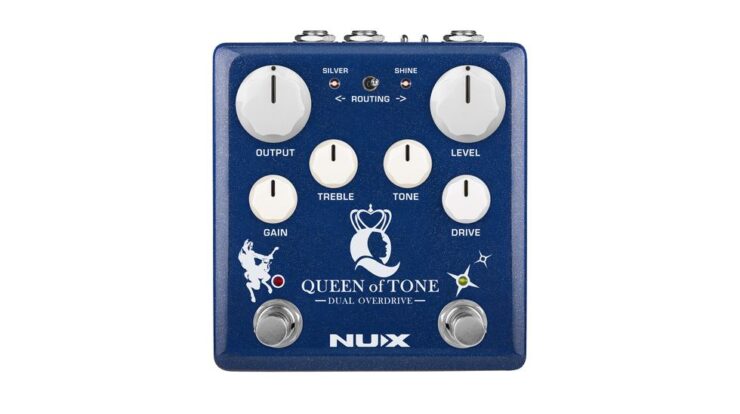

NUX’s Queen of Tone dual overdrive pedal is, at least in name, a clear nod to Analogman’s iconic King of Tone—which is, in a very general sense, a highly modified mash up of two Marshall Bluesbreaker circuits. However the Queen of Tone deviates from Analogman’s approach to the dual-overdrive concept in a significant way: The pedal retains some Bluesbreaker lineage in the form of NUX’s own Morning Star overdrive, a Bluesbreaker-style pedal that makes up one half of the QOT. But the other half of the two-overdrive set up is the Horseman, NUX’s version of the Klon Centaur.
The Morning Star side boasts controls for drive, tone, and level, while the Horseman’s control set consists of gain, treble, and output knobs. A routing switch enables you to switch the order of effects, and a toggle on the crown of the pedal selects true or buffered bypass. A second adjacent mini-toggle engages an input FET Stage that adds even more gain. There are also two hidden features of sorts: Holding down the Morning Star footswitch engages Shine mode, which adds treble boost and clarity. Pressing and holding the Horseman side, meanwhile, activates Silver mode, which extends the gain range of the Horseman circuit. (“Silver” refers to the silver Klon Centaur, which is typically considered treblier and sometimes raspier than the gold iteration).
The two circuits complement each other well and stack seamlessly.
One peculiar aspect of the Queen of Tone switching that’s worth noting: The pedal activates with the release of the footswitch, which enables the press-and-hold function for the Silver and Shine modes. Some players will perceive this as a lag, but if you can adjust your timing without upsetting your rhythm and flow, it’s merely a minor annoyance.
Gain On the Range
I tested the Queen of Tone with a Fender Telecaster and Gibson ES-355, alongside a tweed Deluxe-style 1×12″ combo, and the pedal proved easy to use, extremely versatile, and adaptable to either guitar/amp combination. From the Morning Star’s juicy, dynamic, tube-like clipping to the Horseman’s clear, transparent, and slightly mid-forward response, there are a ton of tones to tap into, and the vast majority of the sounds are not only useful, but loveable. What’s more, the two circuits complement each other well and stack seamlessly, offering a unique gain structure depending on the signal order.
NUX addressed a common issue with Bluesbreaker-style circuits, which often require maxing the level control for adequate output. Here, there’s more headroom to work with, which, along with the extra high-end shimmer from the Shine mode, contributes to a very present tone. There’s plenty of cut and brightness available from the Horseman side, too. For my taste, the Silver mode pushed things a little too bright, but it’s useful when you need leads to soar. Engaging the FET switch also produces a notable increase in gain to either side. But as you might guess, with all the extra brightness and gain already built into the extra circuits, it can be overkill unless you really want to hammer your amp’s front end.
It could be argued that neither of these circuits is quite as lush or transparent as some boutique counterparts. But even discounting the cost savings, which are considerable, both the Horseman and Morning Star hold up very well on the tone front. Brought together in the Queen of Tone, they open up a huge expanse of gain-shaping possibilities.




